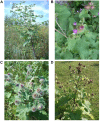Arctium Species Secondary Metabolites Chemodiversity and Bioactivities
- PMID: 31338098
- PMCID: PMC6629911
- DOI: 10.3389/fpls.2019.00834
Arctium Species Secondary Metabolites Chemodiversity and Bioactivities
Abstract
Arctium species are known for a variety of pharmacological effects due to their diverse volatile and non-volatile secondary metabolites. Representatives of Arctium species contain non-volatile compounds including lignans, fatty acids, acetylenic compounds, phytosterols, polysaccharides, caffeoylquinic acid derivatives, flavonoids, terpenes/terpenoids and volatile compounds such as hydrocarbons, aldehydes, methoxypyrazines, carboxylic and fatty acids, monoterpenes and sesquiterpenes. Arctium species also possess bioactive properties such as anti-cancer, anti-diabetic, anti-oxidant, hepatoprotective, gastroprotective, antibacterial, antiviral, antimicrobial, anti-allergic, and anti-inflammatory effects. This review aims to provide a complete overview of the chemistry and biological activities of the secondary metabolites found in therapeutically used Arctium species. Summary of pharmacopeias and monographs contents indicating the relevant phytochemicals and therapeutic effects are also discussed, along with possible safety considerations.
Keywords: Arctium species; bioactivity; chemodiversity; non-volatile compounds; secondary metabolites; volatile compounds.
Figures
References
-
- Aboutabl E., El-Tantawy M., Shams M. (2013). Chemical composition and antimicrobial activity of volatile constituents from the roots, leaves, and seeds of Arctium lappa L. (Asteraceae) grown in Egypt. Egypt. Pharm. J. 12 173–176. 10.4103/1687-4315.124036 - DOI
-
- Ahangarpour A., Heidari H., Oroojan A. A., Mirzavandi F., Nasr Esfehani K., Dehghan Mohammadi Z. (2017). Antidiabetic, hypolipidemic and hepatoprotective effects of Arctium lappa root’s hydro-alcoholic extract on nicotinamide-streptozotocin induced type 2 model of diabetes in male mice. Avicenna J. Phytomed. 7 169–179. - PMC - PubMed
-
- Ahangarpour A., Oroojan A. A., Heidari H., Ghaedi E., Taherkhani R. (2015). Effects of hydro-alcoholic extract from Arctium lappa l.(burdock) root on gonadotropins, testosterone, and sperm count and viability in male mice with nicotinamide/streptozotocin-induced type 2 diabetes. Malays. J. Med. Sci. 22 25–32. - PMC - PubMed
-
- Al-Shammaa D. A., Saour K. Y., Abdul-Khalik Z. M. (2017). Phytochemical investigation for the main active constituents in Arctium lappa L. cultivated in Iraq. Iraqi J. Pharm. Sci. 22 18–24.
-
- Amish Burn Study G., Kolacz N. M., Jaroch M. T., Bear M. L., Hess R. F. (2014). The effect of burns & wounds (B&W)/burdock leaf therapy on burn-injured amish patients: a pilot study measuring pain levels, infection rates, and healing times. J. Holist. Nurs. 32 327–340. 10.1177/0898010114525683 - DOI - PubMed
Publication types
LinkOut - more resources
Full Text Sources



